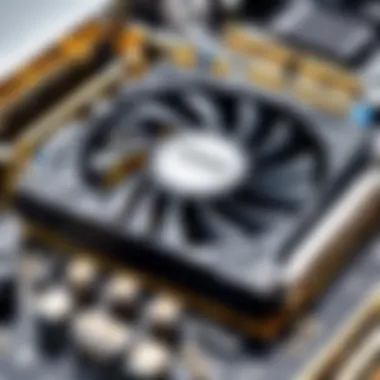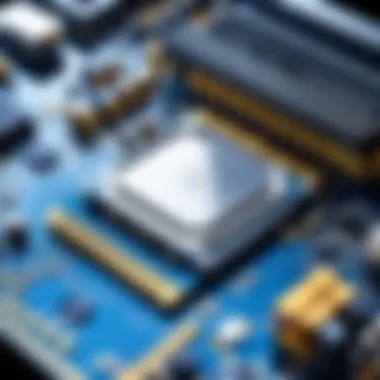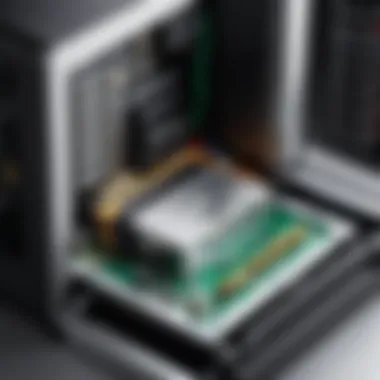Unraveling the Intricacies of Essential Computer Parts for Building a High-Performance PC


When delving into the intricate world of computer parts essential for building a high-performance PC, one must start by understanding the core components that form the backbone of a powerhouse machine. From processors that serve as the brain of the system to graphics cards that render stunning visuals, each part contributes uniquely to the overall functionality and performance of the PC. As technology continues to advance, staying informed about these components is crucial for anyone looking to build a gaming or work machine that stands out in terms of speed, graphics rendering, and multitasking capabilities.
Processors: The PC's Brain
Processors are often referred to as the brain of a computer, responsible for executing instructions and performing tasks effectively. Choosing the right processor is a critical decision as it directly impacts the PC's speed and multitasking capabilities. With options ranging from dual-core to octa-core processors, individuals can tailor their choice based on their computing needs, whether for gaming, graphic design, or everyday tasks. Understanding factors like clock speed, cache memory, and core count is essential when selecting a processor that meets specific requirements.
Graphics Cards: Enhancing Visuals
Graphics cards play a pivotal role in rendering high-quality visuals and supporting graphic-intensive tasks such as gaming and video editing. With key players in the market like NVIDIA and AMD offering a range of GPUs catering to different performance levels, users have the flexibility to choose based on their budget and performance expectations. Factors such as VRAM capacity, CUDA cores, and memory bandwidth influence a graphics card's rendering capabilities, ensuring smooth gameplay and seamless graphics processing.
Memory (RAM) and Storage
While processors and graphics cards are critical components, the seamless operation of a PC also relies on sufficient memory (RAM) and storage solutions. RAM facilitates quick data access and multitasking, with higher capacities enabling smoother performance when running multiple applications simultaneously. On the other hand, storage options like SSDs and HDDs impact the PC's boot time, file transfer speeds, and overall responsiveness. Balancing RAM size and storage technology is vital for achieving a well-rounded computing experience.
Motherboard and Power Supply
The motherboard serves as the foundation that connects all components of a PC, providing communication pathways and electrical power distribution. Compatibility between the motherboard and other components is crucial to ensure seamless functionality and performance optimization. Additionally, a reliable power supply unit (PSU) is essential to deliver stable power to all parts of the PC, preventing overheating and component damage. Factor like form factor, chipset compatibility, and power efficiency should be considered when selecting a suitable motherboard and PSU for a PC build.
Cooling Systems and Case
Efficient cooling systems are imperative for maintaining optimal temperatures and preventing overheating, especially when using high-performance processors and graphics cards. Air and liquid cooling solutions help dissipate heat effectively, ensuring stable performance during intense gaming sessions or CPU-intensive tasks. Choosing a PC case with adequate airflow and cable management options is also essential to promote proper ventilation and organization within the system. Considerations like fan placement, radiator support, and dust filtration can significantly impact the PC's overall temperature regulation and longevity.
Final Thoughts
Building a PC involves a combination of research, planning, and careful component selection to achieve a machine that meets individual performance goals and preferences. By understanding the functionality and significance of each computer part, users can create a customized PC tailored to their specific needs, whether for gaming, professional work, or content creation. From selecting the right processor and graphics card to optimizing cooling solutions and storage options, every decision plays a role in shaping the overall performance and user experience of the PC. Stay informed about the latest technology trends and component innovations to stay ahead in the dynamic world of PC building.
Introduction
In the realm of technology enthusiasts and gaming connoisseurs, the act of assembling a personal computer transcends mere functionality; it embodies a symphony of intricate components working in harmony to deliver unparalleled performance. This article embarks on a journey through the fundamental pillars of computer construction, steering readers towards a profound understanding of each part's role in crafting a customized powerhouse. From blazing-fast processors to cutting-edge graphics cards, the narrative unfolds with meticulous detail, shedding light on the nuanced significance and functionality of each element.
As we navigate through the intricate web of computer parts essential for constructing a high-performance PC, it becomes evident that the choice of components holds paramount importance in shaping the machine's overall capabilities. By delving deep into the nuances of central processing units (CPUs), graphics processing units (GPUs), motherboards, random access memory (RAM), storage devices, and power supply units (PSUs), readers are poised to grasp the intricacies of these vital building blocks. Understanding the synergy between these components is key to unleashing the full potential of a gaming rig or a workhorse workstation, making this exploration a crucial foundation for enthusiasts and professionals alike.
Moreover, this comprehensive guide not only illuminates the technical aspects of each component but also delves into the strategic considerations and benefits that underpin the selection process. By unraveling the complex ecosystem of computer parts, readers are equipped with the knowledge needed to make informed decisions based on performance requirements, compatibility concerns, and budget constraints. The exploration transcends mere hardware specifications, offering a holistic perspective that empowers readers to craft a bespoke PC tailored to their specific needs and preferences.
In essence, this article serves as a beacon for enthusiasts seeking to unravel the mystery of computer components and embark on a journey towards creating a custom-built masterpiece. From novice builders to seasoned veterans, the insights shared herein promise to enrich the experience of assembling a PC, transforming what may seem like a daunting task into a fulfilling creative endeavor.


Understanding the Basics
In the realm of building a high-performance PC, understanding the basics forms the foundation for a successful build. Embarking on this journey necessitates a comprehensive grasp of essential components that define a computer's functionality. From the formidable Central Processing Unit (CPU) to the Graphics Processing Unit (GPU), each element plays a pivotal role in determining the system's capabilities. The motherboard acts as the architectural backbone, connecting all parts seamlessly, while Random Access Memory (RAM) ensures swift task execution. Storage devices safeguard crucial data, and the Power Supply Unit (PSU) fuels the entire setup, underlining the significance of comprehending these basics when customizing a PC to suit specific needs.
Central Processing Unit (CPU)
At the core of any computer lies the Central Processing Unit (CPU), often deemed the 'brain' of the system. This silicon powerhouse executes instructions, processes data, and drives overall performance. When selecting a CPU, crucial factors to evaluate include core count, clock speed, cache size, and thermal design power. Opting for a high-quality CPU assures smooth multitasking, seamless gaming experiences, and efficient resource utilization, elevating the user's computing experience to unparalleled heights.
Graphics Processing Unit (GPU)
The Graphics Processing Unit (GPU) holds the responsibility of rendering images, videos, and animations with precision and speed. Gamers, designers, and content creators benefit immensely from a robust GPU that enhances visual quality and accelerates complex graphical tasks. Key considerations when choosing a GPU encompass memory capacity, CUDA cores, clock speed, and compatibility with software applications. An advanced GPU guarantees breathtaking graphics, fluid gameplay, and swift content creation, reflecting the essence of high-performance computing.
Motherboard
A crucial component in any PC build, the motherboard serves as the central hub connecting various parts and facilitating seamless communication. It determines the expandability, compatibility, and overall efficiency of the system. Factors such as socket type, chipset, form factor, and connectivity options impact the motherboard's functionality. Choosing a well-suited motherboard tailored to specific requirements ensures optimal performance, stability, and future upgradeability, underscoring its integral role in constructing a reliable and flexible computing platform.
Random Access Memory (RAM)
Random Access Memory (RAM) acts as temporary storage for data currently in use by the system. Adequate RAM capacity guarantees swift access to applications and data, fostering seamless multitasking and enhancing overall system responsiveness. When selecting RAM modules, crucial aspects to consider include speed, capacity, latency, and compatibility with the motherboard. Opting for high-performance RAM modules results in improved productivity, faster response times, and enhanced multitasking capabilities, revolutionizing the user's computing experience.
Storage Devices
Storage devices play a vital role in storing and retrieving data efficiently, catering to diverse needs ranging from large file transfers to rapid system boot times. Solid-State Drives (SSDs) and Hard Disk Drives (HDDs) are common storage solutions, each offering unique benefits based on speed, capacity, and cost-effectiveness. Assessing storage requirements, considering readwrite speeds, storage capacity, and durability aids in selecting the ideal storage configuration that optimizes data access and enhances system performance.
Power Supply Unit (PSU)
The Power Supply Unit (PSU) provides electrical power to all components within the PC, ensuring smooth operation and longevity of the system. When choosing a PSU, factors such as wattage, efficiency rating, connectivity options, and modular design play a pivotal role in guaranteeing stable power delivery. Opting for a high-quality PSU with ample power reserves safeguards the system from power fluctuations, fosters energy efficiency, and sustains the longevity of components, solidifying its significance in a reliable and resilient PC build.
Advanced Components
To delve further into the realm of building a high-performance PC, one must understand the pivotal role that Advanced Components play in optimizing functionality and enhancing overall user experience. These components, including Solid-State Drives (SSD), Hard Disk Drives (HDD), and Cooling Systems, are crucial for seamless operations and efficient performance. A Solid-State Drive, or SSD, offers lightning-fast speed and reliability, ensuring rapid data access and reduced loading times for applications and games. On the other hand, a Hard Disk Drive, or HDD, provides ample storage capacity at a lower cost, making it ideal for users with extensive multimedia files or large databases. Additionally, Cooling Systems are essential for maintaining optimal temperatures within the PC, preventing overheating and preserving the longevity of internal components. By incorporating these Advanced Components into your PC build, you can achieve a streamlined and powerful system tailored to your specific needs.
Solid-State Drive (SSD)
When delving into the intricacies of Solid-State Drives (SSDs), one must first recognize their unparalleled speed and efficiency compared to traditional HDDs. SSDs utilize flash memory to store data, resulting in significantly faster read and write speeds, thereby enhancing system performance and reducing boot times. This improved speed is particularly beneficial for gamers and professionals who require rapid access to large files or demanding applications. Moreover, SSDs are more durable and shock-resistant than HDDs, making them a reliable choice for users seeking reliability and longevity in their storage solutions. When selecting an SSD, factors such as capacity, interface, and endurance should be considered to ensure compatibility and optimal performance within your PC system.


Hard Disk Drive (HDD)
In the realm of storage solutions, Hard Disk Drives (HDDs) continue to play a vital role in providing cost-effective and capacious storage options for PC builders. HDDs utilize spinning platters to store data magnetically, offering substantial storage capacities at a lower cost per gigabyte compared to SSDs. While HDDs may lag behind SSDs in terms of speed and performance, they remain a preferred choice for users requiring ample storage for media files, documents, and backups. Additionally, HDDs are suitable for mass storage applications where speed is less of a concern, making them an economical option for budget-conscious individuals or those with extensive storage needs. When choosing an HDD, factors such as storage capacity, rotational speed, and cache size should be evaluated to align with your storage requirements and budget constraints.
Cooling Systems
Effective cooling is paramount in maintaining the stability and longevity of your PC components, especially when dealing with high-performance setups that generate substantial amounts of heat. Cooling Systems are designed to dissipate heat generated by the CPU, GPU, and other components, preventing thermal throttling and ensuring consistent performance levels. Air coolers and liquid cooling systems are two primary options available, each offering unique advantages based on cooling efficiency, noise levels, and aesthetics. Air coolers use fans to circulate air and dissipate heat, while liquid cooling systems employ coolant and a radiator to achieve efficient heat dissipation. When selecting a cooling system, factors such as the CPU socket type, case compatibility, noise levels, and overclocking requirements should be considered to achieve optimal cooling performance and system stability.
Choosing the Right Components
When it comes to building a high-performance PC, selecting the right components is paramount to achieving optimal functionality and efficiency. Choosing the right components entails a meticulous evaluation of each part's specifications, ensuring seamless integration for a cohesive system. By focusing on compatibility, performance, and future upgradability, users can tailor their PC to meet their specific needs and demands. This section will delve into the key considerations and benefits associated with selecting the appropriate components for your PC build.
Factors to Consider
In the realm of choosing the right components for your PC, several crucial factors come into play. One of the primary considerations is the intended use of the computer - whether it's gaming, content creation, or everyday tasks. Each usage scenario dictates different requirements for components such as the CPU, GPU, and RAM. Additionally, factors like budget constraints, performance expectations, and future-proofing the system play a significant role in decision-making. By carefully evaluating these factors, users can create a well-balanced and efficient PC setup tailored to their specific needs.
Compatibility Issues
Compatibility is a critical aspect that cannot be overlooked when selecting components for a PC build. Ensuring that all parts are compatible with each other and with the motherboard is essential for seamless operation. Issues such as socket types, form factors, and power requirements need to be considered to avoid any complications during assembly or system setup. By researching compatibility guidelines provided by manufacturers and double-checking specifications, users can prevent potential bottlenecks or incompatibilities that may hinder the performance of their PC.
Budget Allocation
Budget allocation is a key factor that influences the selection of components for a PC build. Determining how much to invest in each part while maintaining a balance between performance and cost is crucial. Users need to prioritize components that have the most significant impact on overall system performance, such as the CPU and GPU, while still allocating adequate funds for other essential parts like storage and cooling systems. By budgeting effectively and identifying cost-effective yet reliable components, users can optimize performance without breaking the bank.
Assembling Your PC
In the realm of building a high-performance PC, the process of assembling the individual components into a functional system stands as a pivotal stage. Assembling Your PC embodies the culmination of meticulous planning, component selection, and technical expertise coming together to create a personalized powerhouse machine tailored to specific needs. This section serves as the bridge between theoretical knowledge of computer parts and the tangible manifestation of a fully operational PC system.
Preparation
Before embarking on the assembly journey, thorough Preparation is key to ensuring a smooth and successful build process. Firstly, it is essential to allocate ample space in a well-lit, clean environment to work comfortably and minimize the risk of damage to sensitive components. Organizing all the hardware components, tools, and manuals in an orderly manner can streamline the assembly process and prevent any last-minute confusion.
Additionally, perform a visual inspection of each component to check for any physical damage incurred during shipping or handling. Familiarize yourself with the manuals and installation guides provided with each part to understand their placement within the system. Ensuring proper grounding by using an anti-static wrist strap or working on an ESD-safe surface can safeguard the components against static electricity discharge.
Step-by-Step Guide


Understanding the Step-by-Step Guide is crucial for executing the assembly process accurately and efficiently. Begin by installing the CPU onto the motherboard by lifting the retention arm, aligning the CPU with the socket, and gently lowering the arm back into place. Apply thermal paste on the CPU before attaching the CPU cooler to ensure effective heat dissipation.
Next, install the RAM modules into the corresponding DIMM slots on the motherboard, ensuring they click into place securely. Mount the motherboard into the case, aligning the IO shield with the rear panel and securing it with screws. Connect the power supply to the motherboard, CPU, GPU, and drives, ensuring each cable is correctly plugged in.
Continue by installing the storage devices, such as SSDs or HDDs, into the designated drive bays and connecting them to the motherboard via SATA cables. Install the GPU into the PCI-E slot, securing it with screws and connecting the power supply cables. Finally, cable manage all wires neatly, ensuring adequate airflow within the case for optimal cooling.
By following this detailed Step-by-Step Guide meticulously, one can navigate through the assembly process with precision and confidence, culminating in a fully functional PC ready to unleash its performance potential.
Testing and Troubleshooting
Testing and troubleshooting are pivotal stages in the PC building process, ensuring the newly assembled system functions optimally and reliably. Assembling a PC may involve various intricate components, and the initial boot-up represents the crucial moment when all components interact. This phase determines the system's viability and identifies any potential errors or malfunctions that may arise. By conducting thorough testing and troubleshooting post-assembly, users can preemptively address any issues, thereby ensuring a smoother operational experience.
Initial Boot-Up
During the initial boot-up of the PC, each component's functionality is put to the test as the system initializes. This phase involves verifying that the motherboard, CPU, GPU, RAM, and storage devices are correctly installed and operational. Observing the boot sequence and logging any error messages can help pinpoint specific components causing issues. Understanding the BIOS (Basic InputOutput System) and navigating through its settings is crucial during this stage to diagnose hardware-related problems accurately.
Common Issues and Solutions
Common issues during the initial boot-up include RAM or GPU seating issues, incompatible hardware, or power supply failures. If the system fails to power on or display content on the monitor, checking connections, ensuring proper seating of components, and verifying power supply functionality are essential steps. Troubleshooting techniques may involve systematically removing and reseating components, testing individual hardware elements, and consulting motherboard manuals for error code interpretations. By following a structured approach and utilizing diagnostic tools, users can efficiently identify and resolve common boot-up issues.
Optimizing Performance
When it comes to optimizing performance in the realm of building a PC, one must delve into an array of key considerations that can elevate the functionality of the system to unparalleled heights. Optimizing performance is not merely a choice but a crucial step towards ensuring that every component within the PC operates harmoniously, maximizing output while minimizing bottlenecks. Enhancing performance entails fine-tuning various aspects of the computer, ranging from overclocking the CPU and GPU to optimizing cooling solutions and ensuring efficient power delivery.
A pivotal element to address when optimizing performance is ensuring that all hardware components are working cohesively to unleash their full potential. By fine-tuning settings, users can extract every ounce of power from their processors, GPU, and RAM, leading to smoother multitasking, faster load times, and improved overall gaming or computing experiences.
Furthermore, optimizing performance extends beyond hardware manipulation; it also encompasses software optimization. Ensuring that the operating system is streamlined, drivers are up to date, and unnecessary background processes are minimized can significantly impact the system's speed and responsiveness. Moreover, disk cleanup, defragmentation, and utilizing performance-enhancing software can further boost the PC's efficiency.
When navigating the terrain of optimizing performance, it is imperative to strike a balance between pushing components to their limits and maintaining system stability. Overclocking, while a powerful tool for boosting performance, can potentially lead to overheating if not done with caution. Therefore, users must adhere to safe overclocking practices and invest in adequate cooling solutions to prevent thermal throttling and hardware damage.
Ultimately, optimizing performance is a meticulous process that requires patience, attention to detail, and a profound understanding of the intricacies involved. By meticulously fine-tuning hardware and software configurations, users can unlock the full capabilities of their PC, transcending conventional performance limitations and experiencing computing prowess at its zenith.
Conclusion
In this article, we have delved deep into the intricate world of computer parts essential for building a high-performance PC, catering to the needs of esports enthusiasts, technology aficionados, and gaming fanatics. The Conclusion section serves as the culmination of our exploration, summarizing the key takeaways and emphasizing the critical role of meticulous component selection in crafting a powerhouse gaming or work machine.
One essential element highlighted throughout this article is the paramount importance of compatibility when selecting computer parts. Ensuring that components mesh seamlessly together is crucial for optimal performance and stability. By carefully considering the interplay of the CPU, GPU, motherboard, RAM, storage devices, PSU, SSD, HDD, and cooling systems, users can guarantee a smooth and efficient build process.
Furthermore, the Conclusion sheds light on the significance of budget allocation in the PC building journey. Balancing performance requirements with cost constraints demands thoughtful decision-making and strategic planning. By weighing the costs and benefits of each component choice, builders can maximize value and functionality within their budgetary limits.
Moreover, the discussion within the Conclusion section underscores the long-term benefits of investing time and effort into understanding computer parts. Building a PC is not merely a technical exercise; it is a creative endeavor that empowers individuals to tailor their systems to specific needs and preferences. Mastery of component selection fosters a deeper appreciation for the intricacies of computer hardware and unlocks the potential for future upgrades and optimizations.
In essence, the Conclusion encapsulates the essence of our narrative, advocating for thorough research, careful consideration, and an unwavering commitment to quality in the PC building process. By embracing the insights gleaned from this article, readers are poised to embark on their PC building journey equipped with the knowledge and confidence needed to construct a top-tier system that meets their performance demands and exceeds their expectations.



